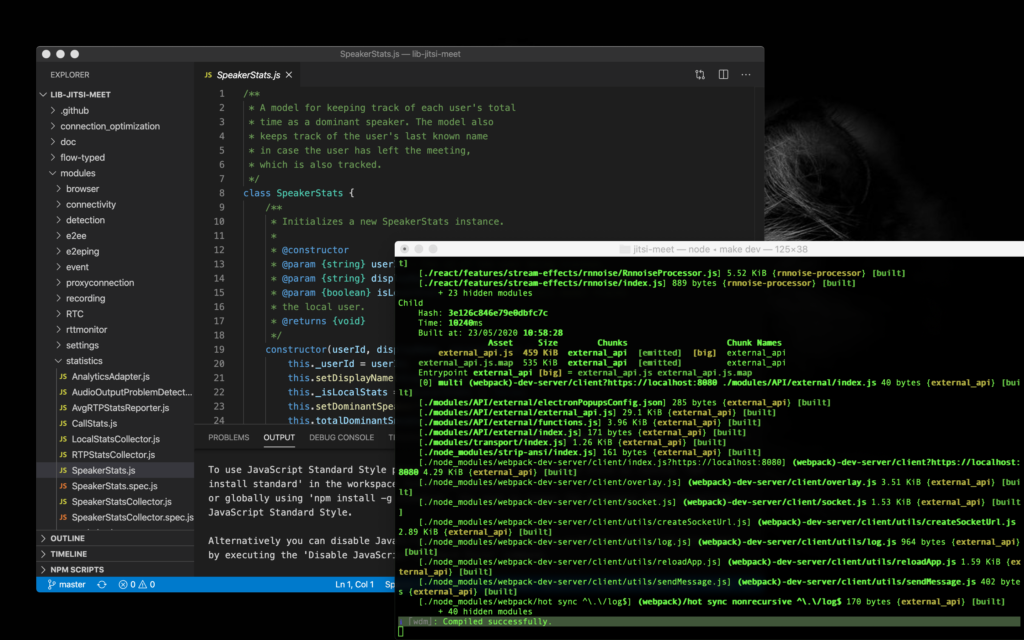weltübergang 2 – Jitsi Social Helpers
English version below
Kleines Helferlein (hashtag: #kleineshelferlein) steht für Projekte, die uns in der “neuen Normalität” zur Seite stehen, für uns in bestimmten Situationen einspringen, und uns darin unterstützen, Nerven und physische Distanz zu bewahren.
Eine 🤯 Idee von Christiane Hütter @frauhue beim Weltübergang 1 war: Wir könnten ja Videokonferenzen gerechter gestalten, in dem dafür gesorgt wird, das die Sprecherinnen*zeiten nach Bedarf und Interesse allokiert werden und alle an die Reihe kommen, nicht nur die dominierenden Persönlichkeiten. @hannah pw erwähnte dort auch us+, das Lauren McCarthy und Kyle McDonald für Google Hangouts entwickelt haben (Code). Dort enstand der Tell Me More Button.
Unsere Reaktion: Au ja, wir kucken auch mal. 👀
Da wir fast ausschließlich die Open-Source Lösung Jitsi (https://jitsi.org/) benutzen, kam die Idee auf, den Jitsi client zu hacken. Jitsi hat bereits die Funktion Sprecher*innenstatistik, in der wir sehen können, wie lange jemand geredet hat. Diese wird allerdings in einem separaten Fenster angezeigt (Bild 1).

Außerdem hat Jitsi die Funktion “Hand heben”, mit der sich Teilnehmende zu Wort melden können. Jedoch verlangt dies eine vorherige Vereinbarung über die Nutzung dieser Funktion sowie aufmerksame Teilnehmerinnen bzw. Moderatorinnen. Bei einer größeren Anzahl von Teilnehmer*innen kann es durchaus vorkommen, daß jemand sich sehr lange oder sogar vergeblich meldet, auch aus eigener Erfahrung (Bild 2).

In einem ersten Schritt wollen wir nun versuchen, in Jitsi die Redezeit im Chat-Fenster jeder Person live anzuzeigen, und auch wie lange sich jemand schon gemeldet hat. Dies ist im Sinne des Nudging, einer Theorie der sanften Beinflussung, die auch auf die Eigenverantwortung der Teilnehmenden setzt, anstelle von Eingriffen von “oben”. Das anarchische Prinzip bei Jitsi unterstützt dies, da jede*r jede*n zu jeder Zeit stummschalten und sogar aus der Konferenz werfen kann. Die Gruppe kann sich so selbst moderieren, ein Prinzip das an den kybernetische Gedanken der Sebstregulation anschließt.

「wdm」: Compiled successfully.Status:
- Wir haben nun Jitsi lokal kompiliert und am laufen (Bild 3). 🤓😎
- Dann haben wir hier den Projektstand dokumentiert. ☑️
- Seitdem sind wir im Jitsi Quellcode auf Forschungsreise. 🤠😳🤗
Noch ist nicht klar wie weit wir kommen, das Team ist sehr am diskutieren gerade, möchte gerne das Nudging-Buch lesen oder bei den anderen spannenden Projekten mit reinschauen oder auch nicht, mal kucken. 🤡
Mockup: Nach intensiver Diskussion und aufgrund der Komplexität des Jitsi Quellcodes haben wir uns entschieden, erst einmal Mockups zu präsentieren. Den Sonntag brauchen wir nämlich für WordPress.
Erstes Feature: Redezeit


Eine Formel wäre: G ~ R - D
wobei: G = Größe der Zeitanzeige, R = Rededauer, D = Durchschnittliche Rededauer aller Teilnehmenden
Zweites Feature: Meldung


Eine Formel dazu könnte etwa lauten: G ~ M / A
wobei: G = Größe der Hand, M = Meldedauer, A = Abgelaufene Dauer des Meeings
Andere Visualisierungen oder Stummmschaltung und Audio-Anpassungen sind denkbar.
Next Steps: Diese Funktionen probeweise implementieren.
Results: Eventuelle Ergebnisse würden hier erscheinen: https://github.com/i3games/jitsi-social-helpers
Kleines Helferlein (hashtag: #kleineshelferlein) represents projects that create “things” who stand by our side in the “new normal”, work as stand-ins in certain situations, and support us in keeping our nerves and physical distance.
An idea by Christiane Hütter @frauhue at Weltuebergang 1 was: We could make video conferences fairer by ensuring that the speaker times are allocated as needed, based on interest and that everyone gets their turn, not just the dominant personalities. @hannah pw also mentioned us+, which Lauren McCarthy and Kyle McDonald made for Google Hangouts (code). Christiane and team are developing the Tell Me More Button
Our reaction: Oh yes, we’ll also have a look. 👀
As we almost exclusively use the open source solution Jitsi, the idea came up to hack the Jitsi client. Jitsi already has a speaker stats feature that allows us to see how long someone has been talking. However, this is shown in a separate window.

In addition, Jitsi has a “raise hand” function, with which participants can speak. However, this requires a prior agreement on the use of the function and attentive participants or moderators. With a larger number of participants, it may happen that someone tries to speak for a very long time or even in vain – a personal experience.

In a first step, we now want to try to show the speaking time in Jitsi live in the chat window of every person, and also how long someone has been in touch. This is in the sense of nudging, a theory of gentle influencing, which also relies on the personal responsibility of the participants, instead of interventions from “above”. The anarchic principle at Jitsi supports this since everyone can mute everyone at any time and even throw them out of the conference. The group can thus moderate itself, a principle that follows on from the cybernetic ideas of self-regulation.
Status:
We have now compiled Jitsi and are running it locally. 🤓😎
Then we spent some time to document the project status here. ☑️
Since then we are on a research trip inside the Jitsi source code. 🤠😳🤗

「wdm」: Compiled successfully.It is not yet clear how far we are going, the team is currently discussing, some would like to read the nudging book or take a look at the other exciting projects or not. 🤡
Mockup: After intense discussions and due to the complexity of the Jitsi source code, we decided to present mockups first. We need the Sunday for WordPress.
Feature 1: Speaker Time


A possible formula: G ~ R - D
where: G = size of the hand, M = reporting time, A = elapsed time of the meeting
Feature 2: Raise Hand


A formula here could be: G ~ M / A
where: G = size of the hand, M = reporting time, A = elapsed time of the meeting
Other visualizations or muting and audio adjustments are possible.
Next Steps: Try implementing these functions.
Any concrete results would appear here: https://github.com/i3games/jitsi-social-helpers
